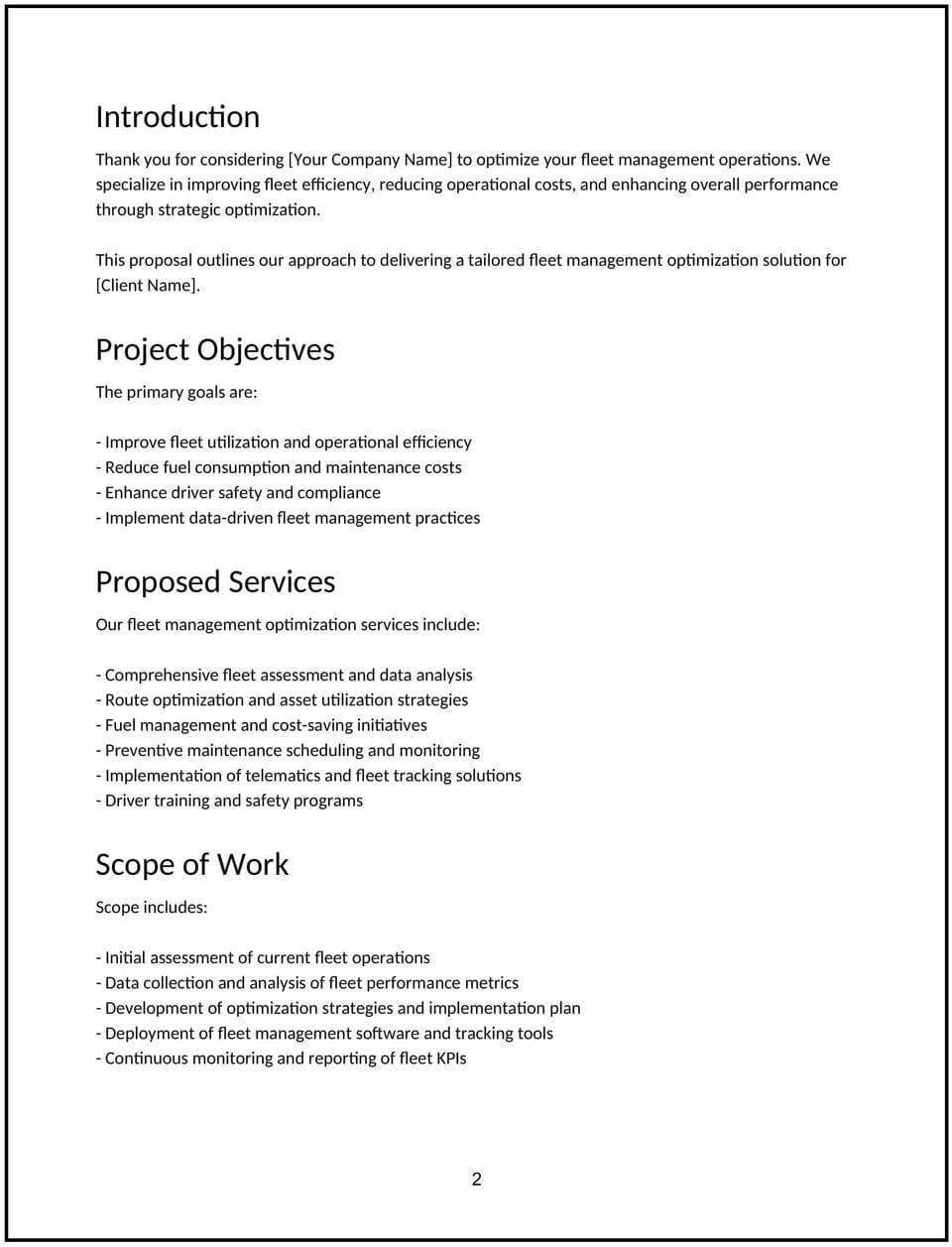Fleet management optimization proposal: Free template

Customize this free fleet management optimization proposal with Cobrief
Open this free fleet management optimization proposal in Cobrief and start editing it instantly using AI. You can adjust the tone, structure, and content based on your client’s fleet size, industry, and performance goals. You can also use AI to review your draft — clarify scope, flag inefficiencies, and tighten language before sending.
Once you're done, send, download, or save the proposal in one click — no formatting or setup required.
This template is fully customizable and built for real-world use — ideal for logistics providers, construction companies, service fleets, or last-mile delivery teams. Whether you’re improving routing, reducing fuel costs, or implementing telematics, this proposal helps you define your value clearly and secure buy-in fast.
What is a fleet management optimization proposal?
A fleet management optimization proposal outlines how you’ll help a business improve the performance, cost-efficiency, and visibility of its vehicle fleet. It typically includes assessments of current operations, technology upgrades, cost analysis, and performance KPIs — all aimed at reducing downtime, improving utilization, and lowering total cost of ownership (TCO).
This proposal is used by fleet consultants, logistics specialists, and operations teams. It’s particularly valuable for companies struggling with maintenance issues, fuel waste, route inefficiencies, or compliance gaps.
Unlike a general logistics proposal, this version is focused specifically on the operational, financial, and technical performance of vehicle fleets.
Why use Cobrief to edit your proposal
- Edit the full proposal instantly: No formatting headaches — just open, customize, and share.
- Use AI to tailor scope: Adjust the proposal based on fleet type, size, industry, and optimization goals.
- Run a full AI-powered review: Catch vague benchmarks, unclear deliverables, or timeline gaps before sending.
- Apply edits in one click: Accept all or review section-by-section.
- Save, send, or download: Export a professional, client-ready PDF instantly.
When to use this proposal
- When helping a client reduce fuel, maintenance, or insurance costs across their fleet
- When offering GPS or telematics solutions to improve vehicle tracking and route efficiency
- When responding to an RFP or internal request to review fleet performance
- When supporting a transition to electric vehicles or more sustainable fleet options
- When bundling fleet analytics with operational or compliance consulting
What to include in a fleet management optimization proposal
- Project overview: Explain the goal — such as reducing operational costs, improving asset utilization, or increasing delivery efficiency. Tailor this to the client’s current fleet challenges and goals.
- Scope of work: List what you’ll cover — including route optimization, telematics review, maintenance scheduling, asset tracking, fuel monitoring, cost benchmarking, and compliance checks. Clarify if this includes software deployment, training, or vendor coordination.
- Timeline: Provide a schedule — from fleet audit and data collection to implementation, pilot testing, and performance review. Include major milestones like system integration or report delivery.
- Deliverables: Specify what the client will receive — such as a fleet efficiency report, optimization plan, telematics recommendations, route maps, and KPI dashboards. Optionally include training materials or SOPs.
- Pricing: Outline your fee structure — fixed fee, per-vehicle rate, or hourly consulting. Note what’s included and if ongoing monitoring, reporting, or support is offered separately.
- Call to action / next steps: End with a clear prompt — approve the proposal, confirm asset count, or schedule a kickoff meeting. Make the next step easy and actionable.
How to write an effective fleet management optimization proposal
- Focus on metrics: Emphasize potential savings (fuel, time, downtime), safety improvements, and utilization rates.
- Tailor to fleet type: Address the specific needs of delivery vans, construction trucks, service vehicles, or long-haul fleets.
- Include technology: Mention telematics, route planning tools, or tracking software to add value.
- Speak to ROI: Use plain-English financial comparisons to show why optimization pays off quickly.
- Make it operational: Clients want practical, low-disruption improvements — not abstract analysis.
- Close with clarity: End with a confident CTA that moves the proposal toward action.
Frequently asked questions (FAQs)
What types of fleets is this proposal suitable for?
Any commercial or service-based fleet — including logistics, field service, utility, construction, transportation, and delivery vehicles.
Does this proposal include software setup?
It can — just clarify whether you're implementing third-party telematics or providing software recommendations only.
Can this help reduce emissions or support EV adoption?
Yes — optimization often includes emissions tracking, fuel efficiency planning, and evaluating the feasibility of electric or hybrid vehicle integration.
Can this be used for multi-location or global fleets?
Absolutely. Just define which locations or fleet segments are included and whether the recommendations apply company-wide or in phases.
Is this proposal a binding agreement?
No — it outlines your services and pricing. A formal contract or statement of work should follow if approved.
This article contains general legal information and does not contain legal advice. Cobrief is not a law firm or a substitute for an attorney or law firm. The law is complex and changes often. For legal advice, please ask a lawyer.